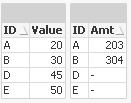Unlock a world of possibilities! Login now and discover the exclusive benefits awaiting you.
- Qlik Community
- :
- All Forums
- :
- QlikView App Dev
- :
- Re: Left Keep Vs Left Join
- Subscribe to RSS Feed
- Mark Topic as New
- Mark Topic as Read
- Float this Topic for Current User
- Bookmark
- Subscribe
- Mute
- Printer Friendly Page
- Mark as New
- Bookmark
- Subscribe
- Mute
- Subscribe to RSS Feed
- Permalink
- Report Inappropriate Content
When Use Keep When Use Join
Hi All,
I have knowledge what is KEEP and JOIN. I am trying to know which scenario will
use KEEP (ex: LEFT KEEP) and which scenario will use JOIN (ex: LEFT JOIN).
Can you people share with examples.
Regards,
Nihhal.
- Tags:
- new_to_qlikview
- « Previous Replies
- Next Replies »
Accepted Solutions
- Mark as New
- Bookmark
- Subscribe
- Mute
- Subscribe to RSS Feed
- Permalink
- Report Inappropriate Content
HI Nihhal,
If you have one to many or many to many relationship then we can use KEEP, because if we use join the records will be duplicated.
Regards,
Jagan.
- Mark as New
- Bookmark
- Subscribe
- Mute
- Subscribe to RSS Feed
- Permalink
- Report Inappropriate Content
Hi,
When any join performs between two tables you get single table but in the Keep join join is perform but you have two tables.
Read some of this
Some Qlikview Joins best documents
Understanding Join, Keep and Concatenate
Different Join Functions in Qlikview
Regards
Anand
- Mark as New
- Bookmark
- Subscribe
- Mute
- Subscribe to RSS Feed
- Permalink
- Report Inappropriate Content
Hi,
Left Keep:
Table1:
LOAD * INLINE
[
A, B, C
1, 1, 1
2, 2, 2
3, 3, 3
];
Table2:
LEFT KEEP (Table1)
LOAD * INLINE
[
B, C, D
2, 2, 2
3, 3, 3
5, 5, 5
];
Result:
2 separate tables
Table 1:
A B C
1 1 1
2 2 2
3 3 3
Table 2:
B C D
2 2 2
3 3 3
Left Join:
Table1:
LOAD * INLINE
[
A, B, C
1, 1, 1
2, 2, 2
3, 3, 3
];
LEFT JOIN(Table1)
LOAD * INLINE
[
B, C, D
2, 2, 2
3, 3, 3
5, 5, 5
];
Result:
1 single table
A B C D
1 1 1
2 2 2 2
3 3 3 3
- Mark as New
- Bookmark
- Subscribe
- Mute
- Subscribe to RSS Feed
- Permalink
- Report Inappropriate Content
Hi,
Assume this example
LOAD * Inline
[
ID,Value
A,20
B,30
D,45
E,50
];
left Keep
LOAD * Inline
[
ID,Amt
A,203
B,304
C,105
];
After this you get

LOAD * Inline
[
ID,Value
A,20
B,30
D,45
E,50
];
left Join
LOAD * Inline
[
ID,Amt
A,203
B,304
C,105
];
Result will be

Regards
Anand
- Mark as New
- Bookmark
- Subscribe
- Mute
- Subscribe to RSS Feed
- Permalink
- Report Inappropriate Content
Thanks for your reply,
which scenarios we use left keep. can you give one example where we have to use only left keep.
Regards,
Nihhal.
- Mark as New
- Bookmark
- Subscribe
- Mute
- Subscribe to RSS Feed
- Permalink
- Report Inappropriate Content
Thanks for your reply,
which scenarios we use left keep. can you give one example where we have to use only left keep.
Regards,
Nihhal.
- Mark as New
- Bookmark
- Subscribe
- Mute
- Subscribe to RSS Feed
- Permalink
- Report Inappropriate Content
functionality wise both are same, only difference is the representation in data model.
keep we will see in to 2 separate tables, join we will see in one single table
- Mark as New
- Bookmark
- Subscribe
- Mute
- Subscribe to RSS Feed
- Permalink
- Report Inappropriate Content
When you left join many table to the master table them it is difficult sometimes to realize which table that particular data is coming from. While when left keep we get to know which data is coming from which table.
Thanks,
Ayush
- Mark as New
- Bookmark
- Subscribe
- Mute
- Subscribe to RSS Feed
- Permalink
- Report Inappropriate Content
Hi Nihhal,
In simple terms when you need to join two tables physically then use Left join (Two tables become one table), if you want to apply join logic and want to keep the two tables then use Left Keep.
Join works similiar to the SQL.
Generally left join used to load master records which are there in Transaction tables, please check below example
Transaction:
LOAD
*
INLINE [
CountryID, Sales
1, 1000
2, 3000
];
CountryMaster:
LEFT KEEP (Transaction)
LOAD
CountryID,
Country
INLINE [
CountryID, Country
1, USA
2, India
3, UK ];
After executing this script you will find two tables Transaction and CountryMaster, and CountryMaster table is having only two records with country USA and India, since UK has no sales in Transaction table.
Load UK in master table is of no use, also it is difficult if there many countries for users to select countries with sales.
Hope this helps you.
Regards,
Jagan.
- Mark as New
- Bookmark
- Subscribe
- Mute
- Subscribe to RSS Feed
- Permalink
- Report Inappropriate Content
Whenever you want to reduce a table (e.g. products) to all entries that occur in another table (e.g. Orders), but without joining the two together.
Peter
- « Previous Replies
- Next Replies »